Zha Jiang Mian is undoubtedly the most well-known noodle dish from Northern China.
These Beijing noodles are so popular that they are served in five-star hotels and by street vendors worldwide. However, due to its popularity, there are variations in how to prepare it in different countries. For example, the Korean version is called Jajangmyeon, made with black bean sauce.
This Zha Jiang Mian recipe was also on the menu in the previous restaurant we operated.
Note: This post may contain affiliate links. Please read my privacy policy for more info. I may receive commissions for purchases made through links in this post. As an Amazon Associate, I earn from qualifying purchases.
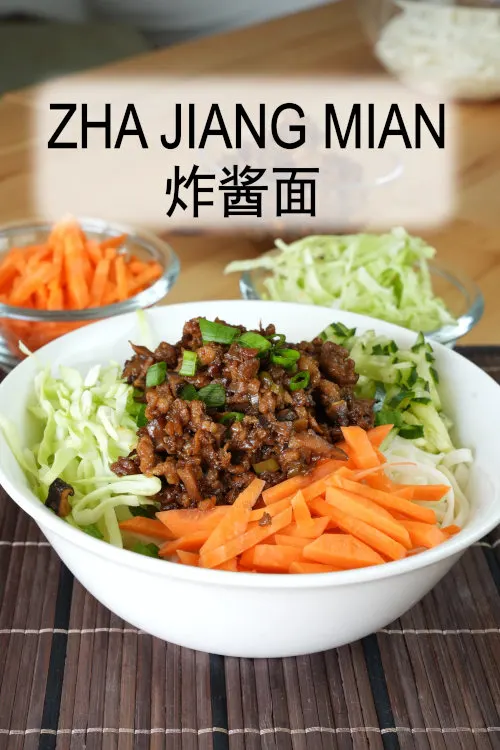
Here are the steps on how to prepare Beijing fried sauce noodles
The meaning of Zha Jiang Mian is fried sauce noodles (炸酱面) in Chinese. The meat sauce looks somewhat like a bolognese sauce but with an entirely different taste profile.
1. The ingredients for the sauce
The key ingredients are minced pork, yellow soybean, and sweet bean paste. Here are the details.
a. Pork belly is the preferred cut of pork
Zha Jiang Mian sauce requires ground pork with a fair share of fat. The meat sauce is then drizzled and mixed with the noodles before serving. Therefore, it is best to make it with pork belly. Otherwise, it should consist of at least 25% fat (or up to 50%) to ensure the minced pork is tender and juicy. During the cooking process, the oil will render from the pork fat, which will be used to fry the bean paste. That is why it is called fried bean sauce.
You can substitute the pork with ground chicken if you prefer a pork-free version. Since cutting the pork belly into small dice is tedious, ground pork with a fair share of fat is also a good substitute for busy home cooks. However, it lacks texture compared to pork cut with a knife.
b. Shitake mushrooms
Sometimes the recipes also include some Chinese shiitake mushrooms in the recipe. Although it is optional, I find that it adds flavor to the sauce.
c. Yellow soybean and sweet bean paste
There are two primary ingredients to make up the sauce.
The first ingredients are yellow soybean paste (also called gan huangjiang, 黄豆酱). it is less common in Malaysia, and sometimes I use Taochu, the Malaysian version of yellow bean paste, as the substitute. Yellow soybean paste is made with fermented yellow soybean, which is pretty salty. That is why it only required a minimum amount of salt in the cooking process.
The second ingredient is sweet bean sauce (Tian Mian Jiang, sweet bean paste, sweet fermented wheat paste, Chinese characters 甜面酱). If you are unfamiliar with sweet bean sauce, it is the sauce used as the dipping sauce for the famous Peking duck.
You should be able to get all these ingredients at the local Asian market. If sweet bean sauce is unavailable, Hoisin sauce can be used as the substitute, although they taste slightly different.
Some formulas include black and broad bean paste (Doubanjiang, 豆瓣酱). Other seasoning ingredients include dark soy sauce, primarily used to darken the color of the sauce.
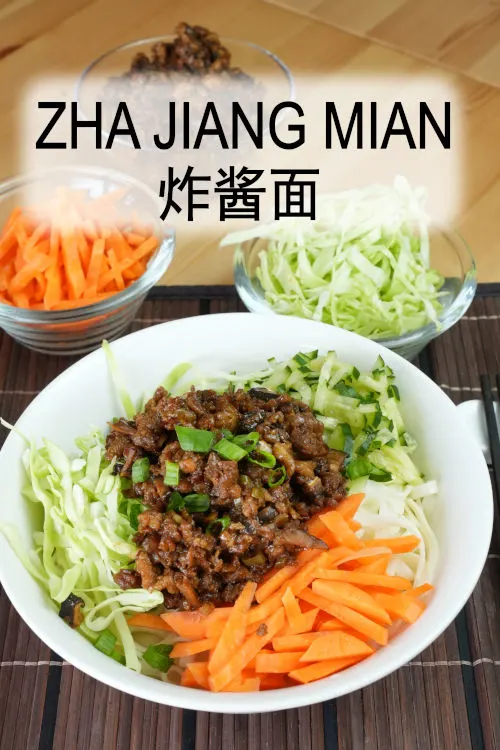
d. Crunchy vegetables
The noodles are served with crunchy vegetables. The common fresh vegetables are bean sprouts, shredded carrots, and julienned cucumber. Some recipes also include extra firm tofu as the topping.
e. The noodles
Fresh noodles are best for this dish, but they may not be practical for a busy home cook. Therefore, I suggest choosing any noodles you can purchase from the grocery store. I have even tried spaghetti and udon noodles, which turned out well.
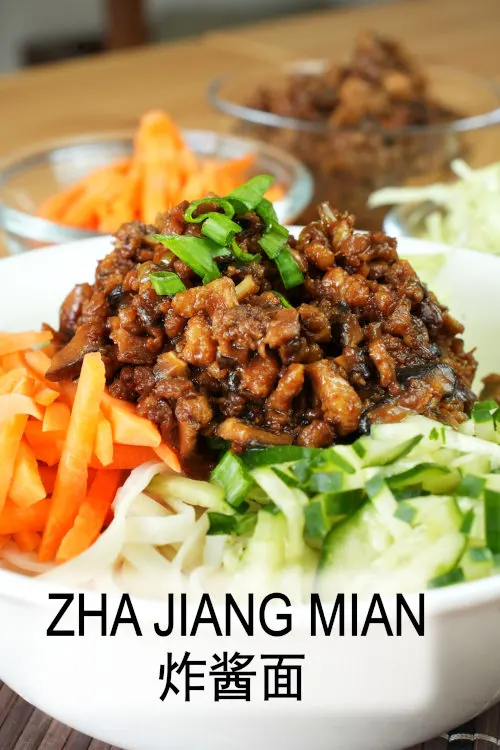
2. How to make Zha Jiang Mian sauce
Here are the steps:
a. Preparation
- Remove the skin of the pork belly. Cut the pork belly into thin slices, then into strips, and finally into small dice. I do not mince the pork finely; I like to retain the texture for the mouthfeel.
- Soak the dry shitake mushroom until soft, remove the stem, and cut them into small dice. Keep the water you used to soak the mushrooms, which is flavorful and be used for cooking the sauce later.
- Coarsely chopped some fresh ginger, garlic, and the white section of spring onions. Set aside.
Note:
There’s no need to marinate the pork because minced pork will absorb the flavors from the sauce immediately during cooking.
b. How to prepare the sauce
- Heat some vegetable oil in the wok.
- Stir-fry the minced pork with the oil over low to medium heat. After a few minutes, the oil will render from the pork fat. The meat will shrink slightly and turns slightly golden.
- Push the pork to the side of the wok. Add the ginger, garlic, and white section of the spring onions to the oil rendered from the pork and continue to stir-fry.
- When it turns aromatic, add the shitake mushrooms, then stir fry for another minute.
- Now include the soybean paste and sweet bean paste.
- Season with salt and sugar.
- Add a small amount of dark soy sauce to darken the color. (optional)
- Pour the water that we used to soak the mushrooms into the wok. Turn to medium-high and continue cooking until it becomes a thick sauce.
- Drizzle some rice wine into the sauce, have a few stirs, and dish out.
3. How to serve the noodles
- Place the cooked noodles in a serving bowl. It is best to use plain noodles to balance the savoriness of the sauce.
- Arrange the julienne vegetables of different colors on the noodles.
- Ladle the minced pork sauce on top of the noodles to serve.
Note:
- The sauce is very versatile, as it is suitable for noodles and perfect as the topping for steamed rice and stuffing for buns.
- I used the Benriner mandoline to cut the vegetable into thin slices. It is a very useful kitchen tool. I highly recommend buying one or any other brand of your choice.
Is Zha Jiang Mian a Chinese or Korean dish?
It is a noodle dish originating from Beijing, China. The name of the Korean version is Jajangmyeon. The ingredients used to make the sauce is a little different as it involves using black bean paste and some oyster sauce.

4. Other Chinese noodles you may like
If you like this noodle recipe, here are some of my recommendations for other noodles you may want to try.
- Ipoh shredded chicken noodles (怡保河粉) is one of the few noodles served with an exotic broth prepared with chicken bones and shrimp shells.
- Rad Na is popular Thai street food. It is a fried noodles dish topped with gravy with meat and vegetables.
- Mee Goreng from Malaysia is a stir-fried noodle dish with curry. Tofu and potatoes are two indispensable ingredients for mee goreng. These noodles are spicy, with loads of chili sauce and sautéed chili paste called sambal.
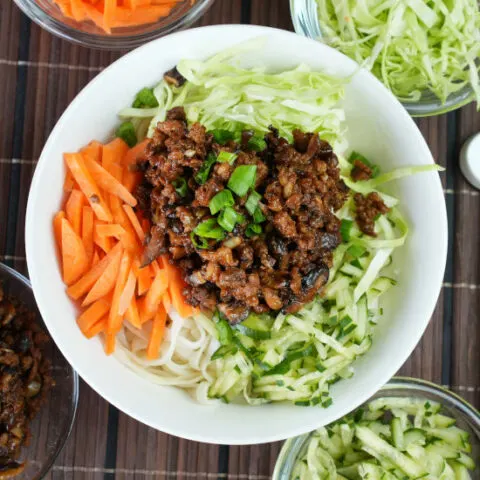
Zha Jiang Mian (炸酱面)
Zha Jiang Mian is undoubtedly the most well-known noodle dish from Northern China.
These Beijing noodles are so popular that they are served in five-star hotels and by street vendors worldwide.
Ingredients
Ingredient A (the sauce)
- 250g pork belly
- 4 dried shitake mushrooms
- 1 tbsp chopped garlic
- 1 tbsp chopped ginger
- 1 tbsp white section of spring onions
- 2 tbsp vegetable oil
- 2 tbsp sweet bean paste
- 3 tbsp soybean paste
- 1 tbsp rice wine
- 2 tsp sugar
- 1/4 tsp salt
Ingredients B (others)
- 1 cup carrot, julliened
- 1 cup cucumber, julienned
- 1/2 cup cabbage, julienned
- 400g noodles of your choice
Instructions
- Cut the pork belly into small dice. Then mince the pork.
- Soak the dry shitake mushroom until soft, remove the stem, and cut them into small dice. Coarsely chopped some fresh ginger, garlic, and the white section of spring onions. Set aside.
- Some vegetable oil in the wok.
- Stir-fry the minced pork with the oil over medium heat until it shrinks slightly and turns golden.
- Add the ginger, garlic, and white section of the spring onions and continue to stir fry with the rendered oil.
- Add the shitake mushrooms, followed by the fermented soybean paste and sweet bean paste.
- Season with salt and sugar.
- Simmer over low heat until most of the water has evaporated and become aromatic.
- Pour the water that we used to soak the mushrooms into the wok. Turn to medium-high and continue cooking until it becomes a thick sauce.
- Drizzle some rice wine into the sauce, have a few stirs, and dish out
- Place the cooked noodles in a serving bowl.
- Arrange the julienne vegetables of different colors on the noodles.
- Ladle the minced pork sauce on top of the noodles to serve.
Recommended Products
As an Amazon Associate and member of other affiliate programs, I earn from qualifying purchases.
Nutrition Information:
Yield: 2 Serving Size: 1Amount Per Serving: Calories: 928Total Fat: 43gSaturated Fat: 11gTrans Fat: 1gUnsaturated Fat: 29gCholesterol: 105mgSodium: 495mgCarbohydrates: 89gFiber: 8gSugar: 17gProtein: 44g
This data was provided and calculated by Nutritionix on 17/10/2022

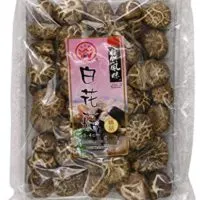



KP Kwan
Friday 21st of October 2022
Hi, this is KP Kwan. I am happy to see you in this comment area, as you have read through my recipe. I am glad to reply to any questions and comments as soon as possible.